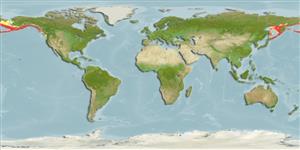Environment: milieu / climate zone / depth range / distribution range
Ecologia
marino demersale; amfidromo (Ref. 51243); distribuzione batimetrica 0 - 775 m (Ref. 6793). Temperate; 66°N - 42°N, 144°E - 124°W
North Pacific: Hokkaido, Japan and Kamchatka, Russia through the Aleutian Islands to the Bering Sea coast of Alaska and Puget Sound, Washington, USA.
Length at first maturity / Size / Peso / Age
Maturity: Lm 56.0, range 54 - 58 cm
Max length : 80.0 cm TL maschio/sesso non determinato; (Ref. 56527); peso massimo pubblicato: 9.0 kg (Ref. 56527); Età massima riportata: 17 anni (Ref. 122394)
Short description
Chiavi di identificazione | Morfologia | Morfometria
Spine dorsali (totale) : 9 - 10; Raggi dorsali molli (totale) : 13 - 16; Spine anali: 0; Raggi anali molli: 11 - 13. Caudal fin slightly rounded (Ref. 6885). Color deep olive on dorsal surface with 4 dark saddles across back; ventral surface pale; brown bars running downward on relaxed unpaired and paired pectoral fins (Ref. 6885).
Occurs in the intertidal area and to 244 m depth, on sand and mud bottoms (Ref. 2850). Feeds on small fishes (Ref. 4925). Often caught near shore (Ref. 2850).
Life cycle and mating behavior
Maturities | Riproduzione | Spawnings | Egg(s) | Fecundities | Larve
Eschmeyer, W.N., E.S. Herald and H. Hammann, 1983. A field guide to Pacific coast fishes of North America. Boston (MA, USA): Houghton Mifflin Company. xii+336 p. (Ref. 2850)
IUCN Red List Status (Ref. 130435)
Threat to humans
Harmless
Human uses
Pesca: commerciale
Strumenti
Special reports
Download XML
Fonti Internet
Estimates based on models
Preferred temperature (Ref.
123201): 0.7 - 6.3, mean 3.2 °C (based on 435 cells).
Phylogenetic diversity index (Ref.
82804): PD
50 = 0.5000 [Uniqueness, from 0.5 = low to 2.0 = high].
Bayesian length-weight: a=0.00832 (0.00544 - 0.01272), b=3.14 (3.01 - 3.27), in cm total length, based on LWR estimates for this species & (Sub)family-body (Ref.
93245).
Trophic level (Ref.
69278): 3.8 ±0.2 se; based on diet studies.
Resilienza (Ref.
120179): Basso, tempo minimo di raddoppiamento della popolazione 4.5 - 14 anni (tm=6-8; tmax=9-13; K=0.08-0.21; Fec=2,00-10,000).
Fishing Vulnerability (Ref.
59153): High to very high vulnerability (68 of 100).
